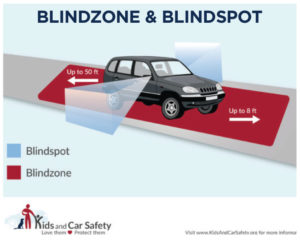Blindspots in the Front of Vehicle
Many drivers have never heard of a frontover accident and many drivers believe they can see everything in front of their vehicle.
everything in front of their vehicle.
A frontover accident is when a slow-moving car, truck, SUV, or other automobile drives forward and strikes a child due to a front blind zone, usually resulting in death.
The blind zones can vary widely based on a number of factors, such as the height of the driver, the size of the object in front of the vehicle, the position of the driver’s seat, and the incline (or decline) of the driving surface. In some instances, a blind zone could be five to ten feet or more in length.
Frontovers often take place in a driveway where children are playing or in parking lots where children run out in front of a vehicle (dart outs). In the majority of accidents, a family member or relative is behind the wheel.
Janette Fennell, the founder of Kids and Cars, says, “It’s impossible to avoid hitting something you can’t see.” She adds, in some instances, “Little ones see a parent get into a vehicle, they think they’re leaving. They don’t want to be left behind. We actually call it the ‘bye-bye syndrome.’”

The National Highway Traffic Safety Administration says frontovers are responsible for 366 deaths a year and over 15,000 injuries. Children are most often the victims.
While new vehicles are required to have back-up cameras, which has resulted in a dramatic drop in backover injuries and deaths, front-facing cameras are not required. Some automakers are now offering front-facing cameras to help drivers, but very few vehicles have them. Even if your vehicle is equipped with front-facing cameras, safety experts say they can give you a false sense of security.
Kids and Cars and other child safety advocates are pushing for mandatory 360 degree cameras and Pedestrian Automatic Emergency Braking on all cars.
If your vehicle does not have a front camera, KidsAndCars recommends that you:
- Walk in front of your vehicle to check for potential dangers before you get in and start the ignition.
- Roll down your window and listen for children.
- Avoid distractions by putting down your cellphone and turning off the radio.
- Account for all toddlers any time someone is arriving or leaving your home to reduce the risk of an unattended child accidentally running into the path of a vehicle.
- Talk to your children about the dangers of vehicles, but never rely on them to protect themselves.


